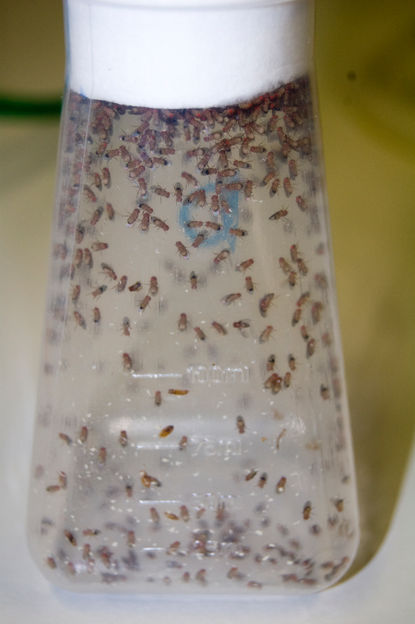An abundance of beneficial mutations
Despite its key importance, the genetic architecture of adaptive processes remains largely unresolved. Now a team of researchers from Vetmeduni Vienna, experimenting with fruit flies, has succeeded in solving at least a part of this puzzle. They were able to show that many genes can contribute to adaptation even though only some of them are actually being used (genetic redundancy).

In fruit flies, many genes can contribute to adaptation, but only some of them are actually being used.
PopGen/Vetmeduni Vienna
Not just since climate change has it been of enormous interest to understand how populations adapt to new environmental conditions. Scientists assume that most adaptations involve a large number of different genes, but most molecularly characterized adaptations are based on only one or a few genes. This discrepancy has been the source of much conjecture but has remained largely unresolved.
Laboratory model: genetic adaptation to different temperatures
To shed more light on this highly interesting area for the field of evolution, a research team from Vetmeduni Vienna used the method of experimental evolution. The goal of the experiment was to study the adaptive processes of fruit flies (Drosophila simulans) in a precisely controlled laboratory setting. The scientists exposed the flies to a hot environment (up to 28°C) over 60 generations and monitored the genetic changes using the latest sequencing methods. In contrast to previous studies, the authors were able to demonstrate that many genes are involved in the adaptation. A surprising result was that different combinations of genes produced similar adaptations in the different experimental populations. This leads first author Neda Barghi to conclude: “Fruit flies possess more paths for adapting to new environmental conditions than they actually use.” Experts call this observation “genetic redundancy”.
Modification of future testing strategies required
This study with fruit flies not only represents a milestone in the field of theoretical evolutionary biology but also has a concrete impact on studies which seek to demonstrate adaptive processes in natural populations. “Usually parallel signatures of selection, i.e., selection signatures found in several populations, are considered to be especially reliable,” explains Christian Schlötterer from the Institute of Population Genetics. “Our study shows, however, that this procedure must be thoroughly reconsidered in order to obtain a complete picture of the adaptive processes.”
Original publication
Most read news
Original publication
Neda Barghi, Raymond Tobler, Viola Nolte, Ana Marija Jaksic, Francois Mallard, Kathrin Anna Otte, Marlies Dolezal, Thomas Taus, Robert Kofler, Christian Schlötterer; "Polygenic adaptation fuels genetic redundancy in Drosophila"; PLoS Biology; 2019
Topics
Organizations
Other news from the department science

Get the life science industry in your inbox
By submitting this form you agree that LUMITOS AG will send you the newsletter(s) selected above by email. Your data will not be passed on to third parties. Your data will be stored and processed in accordance with our data protection regulations. LUMITOS may contact you by email for the purpose of advertising or market and opinion surveys. You can revoke your consent at any time without giving reasons to LUMITOS AG, Ernst-Augustin-Str. 2, 12489 Berlin, Germany or by e-mail at revoke@lumitos.com with effect for the future. In addition, each email contains a link to unsubscribe from the corresponding newsletter.






















































